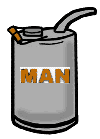|
Past Preventive Maintenance columns: Leveling—Is
It an Issue After Installation? Frequently
Asked PM Questions Machining
Center PM—Index and NC Tables Examining
Accuracies on Machining Centers Zero
Points on Machining Centers—Machining Centers vs.
Lathes Completing
Lathe Maintenance—Tailstock, Sub-Spindle, and
Zero-Point Alignment A
Closer Look at Spindles and Turrets The
Next Level: Accuracy—Checking Backlash on Lathes
Inspecting
the Electrical Cabinet Everyone's
Favorite Task—Cleaning Coolant—The
Most Ignored Fluid in your Machines It's
Summertime—Is your Chiller Working? The
Other Oils—Inspecting the Main Hydraulic Systems
|
MIKE BREEN ON PREVENTIVE MAINTENANCE |
|
Leveling — by Michael W. Breen |
|
|
Twist in the mill will cause premature wear of guides, ways and feed systems. This alone should be enough motivation to check it out. Table Level Machining centers and mills are different from lathes because they have three or more axis planes, whereas most lathes have two. For PM, you will need an indicator and magnetic base or an indicator that mounts into the spindle and a precision gage block (1" to 2" is fine). We need to make sure the table is flat no matter where it is checked. First, stone off the table in the spots you are going to check. Normally, I divide the table into four quadrants, creating nine checkpoints. Place the gage block in one of the corners on the table, mount the indicator to the spindle face, and jog your axis to zero out the indicator. Then, move the block to the four corners of the table and the midpoint of travel on each side of the table. At each checkpoint, move the axis so the indicator can plot all the points. Do not change the depth of the indicator or the results will not be accurate. Flatness of Spindle to Cutting Plane The accuracy needed depends on the application or part. We try to stay within a tenth (0.0001"). If you have a dip of around 0.001", I would advise correcting it by releveling the machine. But, before we get to that, we need to make more checks. Next, sweep the table or pallet tombstone with the spindle. With the indicator mounted in the spindle (so it can rotate), try to create a 6" radius. This will provide a sweep of 12" when rotated. Jog the axis to zero out the indicator to the table (or the cutting surface), and then rotate the spindle by hand. Do not use a commanded speed to rotate the spindle, unless you can afford a new indicator. Centrifugal forces tend to whip them off. This checks the flatness of the spindle to the cutting plane. Once again, there should be no more than a tenth of deviation. Squareness of Axis Ways to Table Use a granite square or cylinder or the pallet tombstone. Normally the block is installed on the tabletop. With the indicator mounted to the spindle, tram the two sides from bottom to top. This checks the squareness of the Y- or Z-axis ways to the table. Once again, we are looking for no more than a tenth. Record all of your findings and the PM part is done. Releveling Be aware that leveling machining centers or mills is more difficult and time consuming than leveling lathes even though the approach is similar. Place two levels 90° from each other (forming a 90° angle) in the center of the table. Start by leveling the machine until Earth level is achieved. Once the machine is leveled, move the machining table to all travel extremes with the levels placed in the middle of the table. The bubble should not move. Next, position the level to the side of the table and move the table all over again. The same results are required. Removing Twist When we are doing this, what are we checking? Ah, you DID read last month’s article; that’s right, “twist.” Your leveling bolt pattern and base will greatly come into play here. I have seen MCs that use three leveling bolts and others that use 36. In general, leveling bolts behind the spindle face will affect the spindle, those around the table will affect the table, and bolts that are under the table and spindle will affect both. The best approach here is “TAKE YOUR TIME.” Use your indicator and gage block as a barometer for adjustments. Normally, a little fine-tuning is all that is required. Remember: when it comes to allotting time to do this, usually conveyors and coolant sumps will have to be removed as will any other obstruction that blocks access to the leveling bolts. If you have never performed this type of PM before, I advise you to do the checks and then have the distributor service engineer show you how to do the rest. Through this process, stick to the service engineer like glue, take notes, and ask questions. Talk to you next month. Mike Breen, a Field Service Engineer with Ellison Machinery Company of Wisconsin, with more than 14 years in machine tool repair, invites you to share your own machine repair and maintenance experiences with him. For comments and inquiries about these articles, his e-mail address is mbreen@ellisonwi.com. - July 2001 |

 Last month we discussed checking and correcting the level on lathes; this month it is machining centers (MCs) and mills.
Last month we discussed checking and correcting the level on lathes; this month it is machining centers (MCs) and mills.